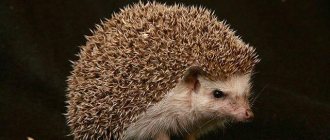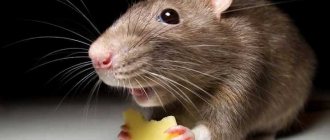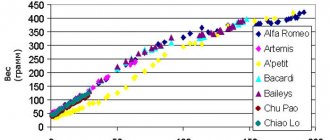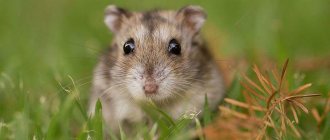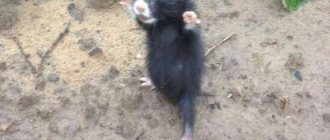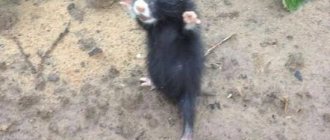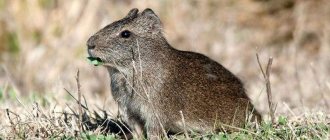Mice are rodents that do not suffer from lack of appetite and can cause enormous damage to food supplies. These animals are considered omnivores, but they have a keen sense of smell and will not try products that contain chemical additives.
And if you know what mice eat in the wild, many mistakes when forming the diet of a domestic decorative rodent can be avoided.
What do house mice eat?
When living with a person as a pet, mice should receive a varied and balanced diet (including occasional treats in the form of fresh vegetables and fruits, seeds, cereals, herbs, nuts, bread, etc.). But on an ongoing basis, it is preferable to feed mice with ready-made food mixtures (with sufficient protein and fiber content) purchased at a pet store. At the same time, you should completely abandon some products.
What can you feed a mouse and what should you not feed it?
The simplest and easiest way to feed pet mice is industrially produced food. When choosing ready-made food, you should pay attention to the manufacturer (it is best if the food is foreign-made) and the composition of the product.
Thus, it is not recommended to purchase mixtures with a high content of oats, peanuts, sunflower seeds and grass granules. It is also worth giving up universal feeds (including those containing dyes). In terms of specific foods, mice can be given the following:
- Cereals (grains of oats, wheat, barley, rye, millet).
- Protein products. Sometimes it is useful to give the little ones a small piece of boiled quail egg, boiled chicken without salt, peeled boiled shrimp (without adding spices, and no more than once a week) and gammarus (dried freshwater crustaceans, which can be found in a pet store).
Feed sunflower seeds with caution. Due to their high fat content, they can be given no more than 3-4 pieces per day (otherwise the mouse will risk obesity).
- Nuts (peanuts, hazelnuts, walnuts). The recommended amount is no more than 1 nut per day.
- Fresh or dried fruits (apples, pears, peaches, apricots, bananas, grapes, kiwi, mango, etc.). They can be given as a treat 2-3 times a week.
- Berries (strawberries, currants, wild strawberries). The recommended norm is a few berries 1-2 times a week.
- Vegetables (cucumbers, bell peppers, cauliflower, pumpkin, broccoli, Brussels sprouts, but most of all mice love fresh carrots). They can be given every other day.
Sometimes you can give Bread (preferably black). It is recommended to give it in small pieces and very rarely - to diversify the diet.
- Greens (lettuce, parsley, cilantro). You can give in small quantities 2-3 times a week.
- Canned food crickets (should account for about 3% of the diet, as they contain a lot of protein, calcium and amino acids).
- Water (at least 25 grams per day). Mice should always have access to clean, fresh water.
- Twigs of apple, rowan and coniferous trees (good for teeth).
Note! Mice love cheese very much, but it is harmful to them because it negatively affects the liver and causes obesity. Therefore, you can give cheese occasionally in small quantities (as a tasty treat).
At the same time, the following foods must be completely excluded from the diet of mice:
- Any fried, salted and smoked dishes (including salted fish, smoked sausage, lard, chips, crackers, fried potatoes, etc.).
- Various sweets (sweets, ice cream, cakes, etc.).
- Food for other animals (dogs, cats, etc.).
- White cabbage.
- Potatoes in any form.
- Tomatoes.
- Citrus and various exotic fruits.
- Beetroot.
- Milk (because it provokes diarrhea, and many pets have intolerance to the product).
- Potent medicinal herbs with a bitter taste (in particular, wormwood, celandine, gentian, etc.).
- Onions (onions and greens).
- Rhubarb.
If, after eating a product, the mouse feels worse and has indigestion (even though the food is healthy), the diet must be urgently adjusted and the product replaced with a safer one.
How can overeating and obesity be dangerous?
Improper or unbalanced nutrition often leads to overeating and subsequent obesity of a small pet. They, in turn, are dangerous because:
- Lead to metabolic disorders.
- Negatively affect liver function.
- Increases the load on the heart.
Which ultimately makes the pet lethargic, sleepy, inactive, causes shortness of breath and alopecia areata (baldness), vascular diseases, gastrointestinal disorders, etc.
What can be given with caution?
Not all products are strictly contraindicated for house mice . Some of them can be given occasionally and in limited quantities (with caution, avoiding overeating), for example:
- Cookies and chocolate (you can give a small piece of a sweet treat, no more than once a week).
- Nuts and seeds (frequent consumption leads to obesity).
- Porridge (mice can be given porridge cooked in water and without adding salt/sugar - instead, it is recommended to add fruits or berries to the finished product).
- Salads (allowed without salt, spices and mayonnaise).
- Meat (you can only give boiled poultry or fish).
- Cheese (very rare and in limited quantities).
Important! The diet of a domestic mouse must be formulated in such a way that the animal receives a balanced diet, but at the same time does not overeat beyond the norm.
Are you trying to diversify your pet's menu?
Ferrets
Ferrets and foxes eat mice Ferrets also eat mice. During the day, the predator is able to catch and devour at least a dozen rodents.
Stocky with a flexible, elongated body, the animal has disproportionately muscular short legs, which allows them to move by jumping and swim perfectly. Long, strong claws on the fingers make it possible to dig deep holes and deftly climb trees. They are used to catch ferrets and mice.
The ferret's body length is about 50 cm, the animal has a flexible neck, an oval head and a slightly blunt muzzle towards the nose. The fluffy tail is a source of pride for the animal (in adults it can reach up to 20 cm). Near it there are special glands that secrete a specific secretion with a pungent odor.
The thick fur covering the animal's body is lighter at the base and darker in color at the tip. It is especially beautiful after the autumn molt, becoming more silky and shiny. The animal's color range can vary from light sand to almost black tones.
What do mice eat in the wild?
The diet of mice in the wild is somewhat different from the domestic species. In particular, wild animals feed on agricultural crops (wheat, oats, rye, corn, millet), mushrooms, berries, nuts, small insects, vegetables, seeds of deciduous trees, plant roots, etc.
What do different types of mice eat, depending on the time of year?
Depending on their species, mice can eat differently (their diet is not very different from each other, but still).
Shrew or shrew mouse
The shrew mouse has a long nose, curved at the end, and is small in size (6-10 cm). Such a mouse is in search of food almost around the clock, because in order to maintain the necessary energy supply, they are forced to consume huge amounts of food . In the warm season, the shrew's diet consists of insects (worms, mole crickets, woodlice, caterpillars, etc.), but in winter mice have to be content with plant seeds.
Japanese mouse
The Japanese mouse has large round ears and a long nose, and prefers to live in mixed forests and on mountainous hills. In spring and summer, the animal eats everything it can find (fruits, berries, grains, vegetables, insects, herbs, etc.). In winter and autumn, mice have a hard time, and since there is not much to choose from, they consume dried insects (if they find them), dry roots and seeds of various plants, etc.
Wood mouse
A distinctive feature of the wood mouse is a round yellow spot on its chest. Animals live in abandoned burrows, in voids under stones, etc. In the warm season, they feed on cereals, nuts, insects, etc. In autumn and winter, the basis of the diet is dried herbs, roots and plant seeds.
Attention! Due to a poor diet during the cold season, most mice do not survive until summer.
Little mouse
The maximum body length of the animal is 7 cm, not counting the tail. The baby mouse prefers to live in grain fields, as well as in the steppe and forest-steppe. The animal is unpretentious in food and eats everything it can (grass, insects, berries, vegetables, etc.). In the cold season, the basis of the diet is seeds and roots of plants.
Harvest mouse
A distinctive feature of the animal is the presence of a clear, contrasting stripe on the skin, running along the entire spine. In the warm season, the field mouse feeds on invertebrate insects, fruits, berries, roots, flowers, plant stems and cereals. In winter, mice are content with tree bark, dried grass and roots. In spring, the basis of the diet is tree buds.
Habitat conditions and diet of wild rodents
Looking at a photo of a field mouse or a house mouse, you can see that these animals are small.
And like all small animals, they have a high metabolism, so they eat often and a lot. During the ripening period, animals can cause enormous damage to agriculture, as they are forced not only to satisfy their daily gluttony, but also to prepare winter reserves. Knowing what a mouse eats, we can easily conclude why its presence in a house or field is unprofitable for humans. It is understandable that people do not want to share their food supplies with rodents. Therefore, they try in every possible way to get rid of the unwanted neighborhood when they find traces of them in storerooms and barns.
In addition to stealing food, the animals also leave their droppings everywhere, so it is no longer possible to use a bag of cereals in which pests were in charge. Rodents also damage the bark of fruit trees, which can lead to the death of seedlings. In Africa, for example, mice completely destroy coffee plantations, causing enormous damage to people.
Rodents carry many diseases. The most dangerous in this regard are not house mice, but field mice. Their feces and urine contain dangerous bacteria that can enter the human body and provoke an epidemic of pseudotuberculosis, hemorrhagic fever, tick-borne encephalitis and other deadly diseases.
We suggest you read: The difference between a baby rat and a mouse
A cat will help you directly in the house and in the yard - these cute animals sometimes cope well with the problem. There are other methods that people have been using for years based on their experience. Let's look at some.
Rodents love to spoil bulbous plants, but do not like daffodils, so they can be planted interspersed. The smell of mothballs is disgusting to many types of rodents, so they can be quite effectively repelled by hanging plastic bottles filled with mothballs on trees. Black film ribbons hung on trees will scare away hares.
To reduce the number of pests in the fields, timely harvesting of crops and removal of straw is important. On virgin lands, the destruction of weeds makes it impossible for rodents to hide from predators
Plowing fields destroys mouse nests, young animals and adults. In a plowed field, it is easier for predators to notice small rodents.
Poisoned baits are often used on farms. They are scattered by hand in places where mouse nests accumulate at least a kilometer away from farms. Such measures allow you to preserve the harvest with minimal losses.
Farms, summer cottages and various agricultural organizations bear the brunt of the damage. They are massively engaged in the production of fruits, vegetables and other things. These are the places where mice are found most often.
These little rodents' teeth grow throughout their short lives, so they have a constant need to chew on something to wear down their teeth. Because of this, they gnaw the bark of trees, their roots sticking out of the ground, after which the tree becomes sick and rots. If they get into the house, they can even chew through the boards in the floors and walls, turning your house or warehouse into Swiss cheese.
Therefore, voles must be destroyed immediately as soon as their presence is noticed, otherwise the consequences can be dire.
conclusions
The diet of mice in domestic and wild conditions is somewhat different, since the decorative species is fed for the most part with special food mixtures and various treats from the table, which the owners carefully treat the pet with.
Mice living in nature have to make do with what is around them. But both of them have extremely short life expectancies . Therefore, when keeping a pet mouse, it is necessary to adhere to a balanced diet, avoiding obesity and the resulting health problems.
Ready-made feed
Today, specialized stores offer a large selection of grain mixtures for domestic rodents. These foods are also suitable for gerbils. Ready-made formulations include grains, healthy herbs, special minerals, and vitamin complexes.
As a rule, the domestic gerbil is offered one or another composition to try. If the animal eats with pleasure, then this food can be used regularly.
There are times when a pet chooses something “tasty” from the proposed mixture and leaves some components of the composition untouched. It should be remembered that the animal did not like it, and in the future do not give the animal such products.
Some gerbils prefer pelleted food. The advantage of such nutrition is optimization of use. The gerbil no longer has the opportunity to choose what to eat and what not, and eats the entire composition.
How to choose bait for a trap?
To destroy rodents in your home, it is not enough to put a tasty morsel in a mousetrap. It is necessary to understand how mice move and where their habitats are. Rodents most often look for food at a distance of 10-25 m from the burrow. Mice are predominantly nocturnal animals; they can make up to 30 nightly forays for food. They move mainly along walls, under furniture. The mouse leaves a trail of excrement behind it. The droppings look like oblong grains, 0.3-1.2 cm in size, black in color.
Experts suggest using pieces of fatty protein food as bait: lard (smoked), bacon, butter, fried peanut or sunflower kernels.
A popular bait that has recently become popular is one made from a lump of peanut butter, which can be purchased at the supermarket. Unrefined sunflower oil on a piece of white bread has also long been an excellent bait for pests.
Benefit
It's hard to overestimate her. And first of all, it again comes from what the mouse eats. The diet of some species includes insects. By eating them, the rodent rids humanity of harmful and annoying insects, which can often also be carriers of viruses. At the same time, being a delicacy for foxes and owls, they make their existence possible. When storing supplies near their burrows, rodents do not always use them completely. And the remaining fruits germinate, giving the forest a new tree or the field a fruit crop.
The benefit of mice for humanity lies in the fact that these animals are often used in laboratory experiments. Vaccines and medicines are tested on them, which will bring enormous benefits to humanity in the future. In addition, these animals are excellent pets that do not require special care. Even the smallest child can look after pets. Being unpretentious and small, as well as easy to train, they will become favorites for your entire family.


